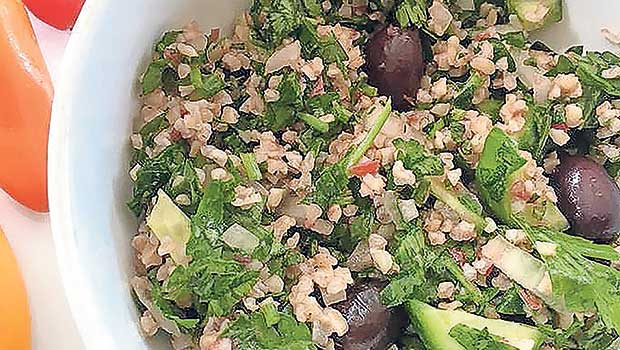Tabbouleh is bursting with flavor
Devour the season’s best with Tomato Juice Tabbouleh

When I used to frequent the IHOP and other such establishments with my homies, I would raise eyebrows by eating the parsley that garnished my sandwich or pancakes. Not the delicate flat-leafed parsley, mind you, but the curly kind that tastes like green steel wool. “Nobody eats the parsley,” I was informed.
I don’t hang out with knuckle-draggers like that anymore, but garnish-sized portions of parsley remain the rule, rather than the exception. But one noteworthy exception is tabbouleh (aka tabouli), the Mediterranean parsley salad. And I have a tactic for making tabbouleh that will blow the doors off of any other you’ve tried.
My trick comes by way of a farmer friend, as many of my best tricks do. The making of a typical batch of tabbouleh begins by cooking the bulgur wheat, also known as chopped wheat grains, while gluten-haters often use quinoa instead.
Instead of cooking the grain,
my farmer friend opts to puree a mess of the juiciest tomatoes available, with garlic, and rehydrate the grain by soaking it in the resulting slurry. Bulgur that’s rehydrated in fresh, garlicky tomato juice has more flavor than bulgur that was rehydrated in plain water, as well as a pleasing red color.
Currently, many tomatoes are sagging under their own weight on vines and windowsills near you. At the end of the farmers market, growers will often cut deals on the extra-soft-and-juicy specimens that are too unstable to survive the trip home, or to unload to restaurateurs. Those fruits, the kind you can barely even slice in half without flooding the kitchen, are exactly the ones you want to use in Tomato Juice Tabbouleh.
Ari LeVaux writes Flash in the Pan, a syndicated weekly food column that’s appeared in more than 50 newspapers in 25 states. Ari lives in Montana and New Mexico and can be reached at flash@flashinthepan.net.
Tomato Juice Tabbouleh
(Ingredient quantities are flexible; feel free to improvise)
• Enough tomatoes for 2-plus cups soupy puree
• 2 cloves garlic, plus or minus to taste (grated, chopped or pressed)
• 1 cup bulgur
• 3 tbsp lime or lemon juice (and have more on hand to add to taste)
• 4 cups chopped parsley (packed cups, not loose)
• 1 small handful mint leaves, chopped
• ½ tsp salt (extra to taste)
• 1 cup onions, finely chopped or minced in a food processor
• 2 cups cucumber chunks, small or large
• ½ cup extra virgin olive oil
• Optional: olives, whole or chopped
Mix and match whatever tomatoes are available and juicy, from lipstick red slicers to yellow cherries to mottled, funky heirlooms. With low-acid tomatoes like Brandywines you may need to add more lemon/lime.
If you can cut the tomatoes into quarters without spilling any juice, do so. Otherwise put them whole into the food processor. Add a pinch of salt and the garlic, and blend. For every two cups of this pinkish soup, mix in a cup of bulgur wheat, along with the lime juice. Let it sit for two to three hours.
Before washing the parsley, untie the bunches and look through them, picking out any yellow or rotten leaves. Assuming no slime, decay or other nastiness, wash the bunch by gripping the stem end and dunking the leaf end in a big bowl of clean water with a tablespoon of vinegar. If the water stays clean, you’re done. If the water’s dirty, change and repeat until it stays clean after dunking.
Holding the bunch by the stem end, chop the parsley leaves. If using mint, add it a little at a time, because a little can go a long way.
Combine the tomatoey bulgur, parsley and mint in a bowl, including salt, onion, cucumber and olive oil. After mixing, adjust salt and lime if necessary, and mix again. It’s ready to eat immediately, but if you let the ingredients get to know each other better over the course of an afternoon, that bonding will pay off.






